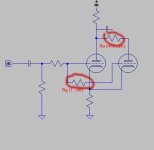Hello, do you think that the small resistances at the anode and the grid can help the coupling of the two parallel triodes due to the inherent different characteristics of the two tubes?
For example any pro or cons for 2K at the grid and 470 ohm at the anode (the B+ is connected to a 75K ohm)?
For example any pro or cons for 2K at the grid and 470 ohm at the anode (the B+ is connected to a 75K ohm)?
Attachments
Connect the anodes together. Connect the cathodes together, use a 10k resistor in series with each grid as a grid stopper to avoid parasitic unwanted noise and oscillations.
If it is an ECC83, for instance, 10k on pin 2 and 10k on pin 7, then connect the resistors together at the far end.
If it is an ECC83, for instance, 10k on pin 2 and 10k on pin 7, then connect the resistors together at the far end.
Just parallel them. If you are using grid stoppers then give each grid its own stopper.
Adding extra resistors to one triode as shown in the first post does not help the coupling but merely ensures that the two triodes are more different than they started out being.
Why do you want to parallel them?
Adding extra resistors to one triode as shown in the first post does not help the coupling but merely ensures that the two triodes are more different than they started out being.
Why do you want to parallel them?
- Status
- Not open for further replies.
